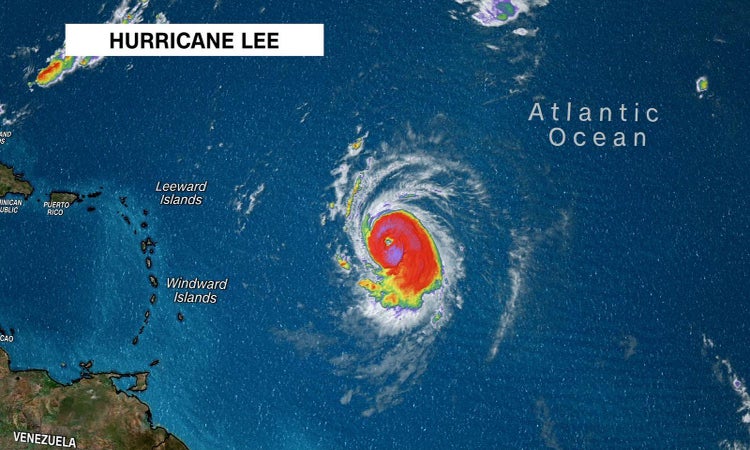Newsmatro

Hurricane Lee, currently a Category 3 storm, is poised to bring dangerous surf conditions, rip currents, and the threat of coastal erosion along the US East Coast. As residents and authorities brace for its impact, concerns are growing about the potential devastation it could bring to coastal communities.
Josh Wagner, a lifelong surfer and beachfront homeowner on Florida’s Atlantic coast, has experienced firsthand the destructive power of hurricanes. He recalls how Hurricane Nicole forced him to take desperate measures to save his home near Daytona Beach last fall. Now, he is worried that Hurricane Lee could combine the worst of both worlds – unfavorable surfing conditions and destructive coastal impact.
Unlike the clean and beautiful waves distant hurricanes often bring to Florida’s coast, Hurricane Lee is expected to churn up choppy and unsuitable waves for surfers. Additionally, the storm’s high risk of rip currents could erode the recently replenished beaches near Ponce Inlet, exacerbating the coastal erosion problem.
As of Monday evening, Hurricane Lee maintained its Category 3 status, with sustained winds of 115 mph. While the significant winds are likely to remain offshore for most of the US coast, the National Hurricane Center and National Weather Service are warning of rip currents and dangerous surf conditions.
“It’s going to produce a tremendous amount of energy in the ocean in the form of traditional ocean waves,” warns Jamie Rhome, the hurricane center’s deputy director. “When that energy strikes the coast, it produces this huge rip current risk.”
Current Location and Path
At 11 p.m. on Monday, Hurricane Lee was approximately 580 miles south of Bermuda and 410 miles north-northwest of the northern Leeward Islands, moving west-northwest at 7 mph. A Saildrone located 40 miles south-southeast of the storm’s center reported a sustained wind speed of 77 mph and a gust of 105 mph. A buoy between Hurricane Lee and San Salvador Island in the Bahamas reported significant wave heights of 17.7 feet. Lee is expected to strengthen to 120 mph winds overnight Monday before encountering wind shear and colder water in the coming days.
Uncertain Path Ahead
The hurricane’s future path remains uncertain, making it challenging to predict how it might impact the northeastern US and Canada’s Atlantic coast. Hurricane Lee is forecasted to gradually turn northward by Wednesday, passing between the US mid-Atlantic and Bermuda on Friday. It could bring strong winds, rainfall, and high surf to Bermuda. Along the coast of New England and Maine, the National Weather Service states that the track, intensity, and impacts of Lee remain uncertain. As of 11 p.m., eastern New England, including parts of the Boston metro area, Cape Cod, and the islands of Martha’s Vineyard and Nantucket, were within the hurricane center’s “cone of uncertainty.”
Rip Current Concerns
Rip currents are a significant concern for weather officials, given that 2023 has already witnessed at least 75 deaths attributed to rip currents and hazardous surf conditions, making it the third-deadliest year on record. A report by the American Meteorological Society revealed that the percentage of direct fatalities linked to tropical-cyclone-related rip currents has doubled in recent years.
“The reason rip currents are so deadly is because all the other hazards in a hurricane have a visual cue,” explains Rhome. Unlike other hazards with visual cues, rip currents are not easily detectable. Beachgoers are often lured to the shoreline by near-perfect beach weather created by sinking air around hurricanes. Wagner, who has observed more rip currents since recent hurricanes, advises people to enter the water near lifeguards.
Forecast for Lee Along the Coast
Swells from Hurricane Lee are already affecting areas between Florida and North Carolina. In Melbourne, Florida, surf conditions are expected to become increasingly rough, while Wilmington, North Carolina, could see surf heights of up to 5 feet. The Outer Banks, North Carolina, faces a very dangerous situation with seas reaching 10-15 feet, posing a threat of beach erosion, ocean overwash, and coastal flooding.
Safety Measures for Rip Currents
If caught in a rip current, experts advise against attempting to swim directly back to shore, as rip currents are stronger than most swimmers. Instead, swimmers should swim parallel to the shore to escape the current or relax and float until they are out of its grip.
Future Concerns
For coastal communities like Josh Wagner’s, the threat doesn’t end with Hurricane Lee. Another storm brewing off the west coast of Africa has surf forecasts predicting 20-foot swells in about two weeks, raising concerns about their ability to withstand additional storms.
“If we get hit by another storm, we’ve got no defense,” Wagner says. His community, already impacted by Hurricane Ian and Hurricane Nicole, remains at risk, with the potential for catastrophic consequences. As they prepare for the challenges ahead, the resilience of these coastal communities is put to the test, facing the unpredictable forces of nature.